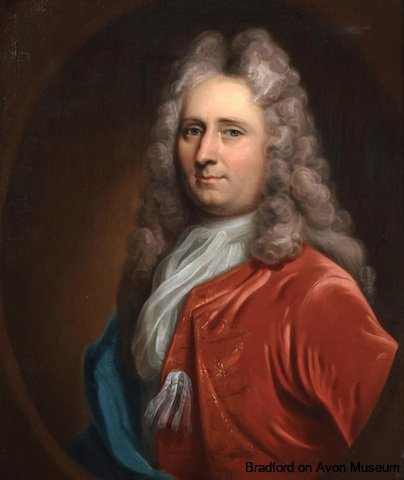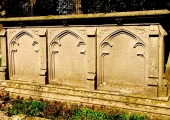.
John Bailward (1677-1742)
Bradford on Avon, Wiltshire
.

Portrait in oils on canvas by a follower of Jean Baptiste van Loo (1684-1745)
Acquired by Bradford on Avon Museum in 2021
John Bailward was one of those who were involved with the lucrative manufacture of woollen cloth in Bradford on Avon in the early part of the 18th century, and founded a dynasty with connections in Bradford that lasted until the 1870s.
Daniel Defoe wrote in the mid-1720s that “the finest Spanish medley cloths not in England only but in the whole world are made in this part … Bradford and Trowbridge are the two most eminent clothing towns … many of the families who now pass for gentry … have been originally raised from and built up by this truly noble venture”. Clothiers built up large fortunes by acting as middle men in each of the transactions involved in the various processes between raw wool and the finished cloth that was notably exported to the Continent and was the mainstay of the English economy. Chief among the clothier families that were here around the time Defoe came to Bradford were the Shrapnels, Methuens, Tugwells and Heylyns, but many more, like the Bailwards, were involved.
So far, we know little about John Bailward’s beginnings, where he was born and who were his parents, although he is likely to have come from a Wiltshire family under the spelling “Ballard”, probably changed for gentrification, because it means “baldy”! He was probably the son of Robert Ballard of Wingfield and Ann Gollidge of Trowbridge who married in 1675. Robert was Churchwarden of St Mary’s church in Wingfield in 1687 and he was buried there in 1697; his wife lived until 1710. Robert and Ann also had a daughter, Ann, who may have been older than John and in 1700/1 at Wingfield married Thomas Reason alias Marshman, yeoman of Farleigh Hungerford. Thomas Reason may have been a Quaker, as a barn belonging to a James Reason alias Marshman was registered as a Quaker meeting house in 1693. They had at least eight children, six daughters and two sons, of whom Margaret married James Crabb, a druggett maker of Rode (Road at the time) at Tellisford in 1726 and Ann married Walter Grant of Monkton Farleigh at Wingfield in 1744.
Sir James Tillie of Belle Cour in Wingfield referred to him as his “kinsman” and Bailward was to become executor of Tillie’s will and a trustee of the contents of his Pentillie Castle in Cornwall. Other strong connections seem to have been with members of the Quakers Friars Meeting at Broadmead in Bristol, who included William Penn, the founder of Pennsylvania in America and through the Quakers of Bristol to families from Cornwall.
It is likely that there was an older John Bailward, perhaps a brother of Robert, and he must have been the one who figures as a witness to some deeds at dates before the John Bailward of the painting had turned 21 in 1699 and perhaps a little later. This one was referred to as John Bailward “of Winfield” (Wingfield) in 1698 and “of Rowlie” (Rowley, in Wingfield and Farleigh Hungerford) in 1704.
However, it is in east London that John Bailward first turns up, in 1710, working for Thomas Perrin (1678-?1742), one of a group of Bristol Quakers who set up as merchants on the eastern side of the city. Perrin had a colourful career importing tobacco from America and had some involvement in the slave trade, but ended up in the Fleet Prison owing thousands in unpaid excise duty. He managed to get free after a few years, escaped to Holland and then to America, where his father Edward had left him land in Maryland and Pennsylvania. For some reason, he was allowed to come back to England by the Treasury in 1732 (although a document of 1717 called him “deceased, late of London” and in the same document John Bailward was styled “gent.”).
In 1699 Thomas Perrin had married Sarah, the eldest daughter of Samuel Groom jr, another Quaker America merchant in the East End of London, who was said to have left £30,000. John Bailward married her younger sister Constant (1686-1746) in 1713. Constant, sometimes called Constance, had been previously married in 1704 to John Owen, a haberdasher of Stroud, Gloucestershire who died in the following year.
John Bailward must have come (back) to Bradford on Avon by 1715, when his elder son John jr was born at nearby Farleigh Hungerford, or perhaps soon after his marriage and the arrest of Thomas Perrin. John and Constant were described as “of Hungerford Farley” in the same year. They had a second son, Samuel, who was born in 1718, but died in 1727. They had moved by 1723 into the house in St Margaret’s Street that had been the home of Zachariah Shapnel before he bought a house and country estate at Midway Manor, Wingfield. Shrapnel made Bailward an overseer and witness to his will and referred to him as “my cousin”, but the relationship is not known. In 1723 too Bailward was involved in the marriage of Shrapnel’s nephew, another Zachariah.
Some of the children of Thomas Perrin and Sarah Groom came to Bradford on Avon, with or following the Bailwards, in the absence of their father. When Samuel Perrin, the oldest son of Thomas and so a nephew of Constant Bailward, died in 1728 he described himself in his will as “late of London but now of Bradford in the County of Wilts.” He seems to have been operating as a clothier and bequeathed his dye books to James Willit [Willett] the Younger “if he becomes a Clothier” (James Willett sr was another Bradford Quaker and John Bailward was a witness to his will in 1731). Samuel’s sister Mary Perrin was also called “of Bradford” when John Bailward was involved in a bond for her marriage to John Southall, a mercer of Leominster, Herefordshire in 1741. Sarah (1721-1787), the youngest child of Thomas and Sarah Perrin, was also described as “of Bradford, spinster” in 1744.
When Bailward came to make his will in 1736 he described himself as “of Bradford gentleman”, but he did not die until six years later, in 1742. His wife Constant died in 1744 and they were both buried in a vault at the Quaker Meeting House at “Comerwell” (Cumberwell, actually by the Bath Road at Frankleigh, now a private house). He chose as trustees of his estate for his son his “well beloved ffriends” Truman Harford (1703-1756), Quaker merchant of Bristol and Ezekiel Dickinson (1711-1788), another Quaker, of Monks Park, Corsham who bought Bowden Park, Lacock in 1751.
In his will he remembered his “late sister [-in-law] Sarah Perrin’s children”; John Burroughs of Southwark, who was a son of Ann Perrin, another of Constant’s sisters-in-law; and his late “sister Reason’s children” -the children of Ann and Thomas Reason. He also mentioned property in Gloucestershire that may have come from Constant’s first marriage and at Haverhill on the border of Essex and Suffolk that she inherited from her father Samuel Groom.
John Bailward the Younger was apprenticed by his father in 1731 to one of Bradford’s main clothiers, Humphrey Tugwell, for £100. He married in 1744 Ann (1713-1788), daughter of Thomas Shewell, a London merchant. This might have been the partner of Samuel Whitbread at the time of the foundation of his famous brewery in 1744, or a mercer (dealer in fine fabrics) who may have descended from a line of drapers and merchants in Bristol. Thomas Shewell bought the lease of a house next to the bridge at Iford in 1725 and in 1739/40 Elizabeth Shewell “of London” and her children, including Ann, were involved in an “assignment of a term to attend an inheritance” of the same property with John Shewell of Bradford. Possibly Thomas had died and his daughter Ann was to marry John Bailward jr four years later. John Shewell paid the Church Rate in Bradford in 1726, was described as a “baker of Bradford” in 1727, “of Iford” in 1729 and “of Bradford gentleman” in his will of 1736.
John jr and Ann drifted away from Quakerism towards the Methodists, becoming friends of John Wesley, who visited them when he was in Bradford. Sarah Perrin also became a follower of Wesley, worked for him at Wesley’s New Room in Bristol, corresponded with Charles Wesley and married Dr John Jones, one of his main supporters. When Ann Bailward died in 1788 she left money for the Preachers’ House in Market Street.
In April 1784 John jr shot himself while his family was at Holy Trinity church, where they owned pews; the Coroner’s verdict was lunacy, the standard response to suicide at the time. Of the children of John Bailward jr and Ann Shewell only one son, Samuel (c1746-1800) survived; another son, Thomas (born and died in 1746) and three daughters, Elizabeth Constant (baptised 1747/8), Anna Maria and Mary (both died 1757) were buried at Wingfield.
Samuel Bailward continued the family clothier business and, by marrying Anna Maria (c1757-1835), the only child of William Stevens and granddaughter of Paul Methuen, became linked to a branch of the Methuens, another of the most powerful clothier families. Samuel Bailward and William Stevens formed a partnership; a cloth pattern book and dye recipe book from the firm have survived and are in the Wiltshire & Swindon Archives.
William Stevens owned Frankleigh House, next to the Bath road outside of the town, which he inherited from his uncle John Lea, whose will John Bailward had witnessed in 1725. Stevens is named as the owner of the painting of John Bailward on a label on its back. With Stevens’ death (his will was proved in March 1808), Frankleigh and its estate came to his daughter Anna Maria and so into the Bailward family, in which it continued until the 1870s. Samuel and Anna Maria had ten children, several bearing names that reflected their family history, such as Henry Methuen Bailward, Thomas Shewell Bailward, William Stevens Bailward, Samuel Groom Bailward and a 3rd (or 4th) John Bailward.
Samuel Bailward became wealthy enough to purchase Horsington Manor, near Wincanton in Somerset in 1787 and this became the family’s main residence as the estate of country gentry, until it was sold in 2001. Frankleigh House in Bradford became the dower house when Thomas Shewell Bailward succeeded his father at Horsington; his mother continued to live there and the youngest brother, John, until his marriage to Elizabeth, the daughter of Rev John Hopkins Bradney of nearby Leigh House in 1841. It was extended in 1848 as the home of Elizabeth Sarah, Julia Susannah and Amelia, Samuel and Anna Maria’s three unmarried daughters and numerous servants. The house was sold off, with 290 acres of land, after the death of the last daughter (Julia) in 1877.








